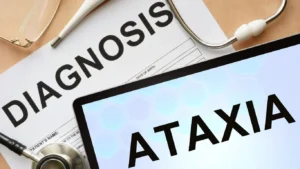In the complex landscape of health, gluten ataxia symptoms emerge as enigmatic signals from the nervous system, weaving a mysterious narrative that perplexes both patients and practitioners alike. Imagine a world where subtle clues, often overshadowed by the daily humdrum, hold the key to unraveling a web of neurological intricacies.
Today, we embark on a journey to shed light on the captivating and elusive realm of gluten ataxia symptoms. Brace yourself for a voyage into the unknown, where questions outnumber answers and the pursuit of understanding beckons with anticipation.
What is Gluten Ataxia

Gluten ataxia is a neurological condition characterized by the body’s immune response to gluten, a protein found in wheat, barley, and rye. In individuals with gluten ataxia, the immune system mistakenly targets the cerebellum, the part of the brain responsible for coordinating movement.
This immune reaction triggers inflammation, leading to a range of symptoms such as unsteady gait, lack of coordination, and difficulties with fine motor skills. Unlike celiac disease, which primarily affects the digestive system, gluten ataxia primarily targets the nervous system.
Prompt recognition and management of gluten ataxia involve adopting a strict gluten-free diet to mitigate symptoms and prevent further neurological damage. As a lesser-known but significant manifestation of gluten sensitivity, understanding gluten ataxia is crucial for timely diagnosis and appropriate intervention.
Key Symptoms of Gluten Ataxia
Gluten ataxia, a manifestation of gluten sensitivity, unfolds with distinct neurological symptoms that demand recognition. The intricate interplay between gluten and the nervous system manifests in a spectrum of challenges, marking the journey of those grappling with gluten ataxia.
Key Symptoms of Gluten Ataxia:
- Coordination Issues: One hallmark of gluten ataxia is a notable lack of coordination and balance, resulting in an unsteady gait and frequent stumbling.
- Motor Skill Impairment: Fine motor skills are often compromised, making tasks like writing, buttoning a shirt, or handling small objects challenging for individuals with gluten ataxia.
- Speech Disturbances: Gluten ataxia can affect speech, leading to slurred or irregular patterns, making communication a struggle.
- Involuntary Muscle Movements: Some may experience tremors or involuntary muscle movements, further contributing to difficulties in precise movements.
- Dizziness and Vertigo: Gluten ataxia may present with persistent dizziness and vertigo, intensifying the challenges in maintaining balance.
- Eye Movement Abnormalities: Abnormalities in eye movements, such as nystagmus, can be indicative of gluten ataxia and contribute to visual disturbances.
- Cognitive Impairment: In some cases, cognitive functions may be affected, with issues like memory lapses and difficulty concentrating.
Neurological Manifestations of Gluten Ataxia
Delving into the intricacies of gluten ataxia unveils a realm where the immune response to gluten intricately entwines with the delicate fabric of the nervous system. The neurological manifestations of gluten ataxia offer a profound insight into the nuanced challenges faced by those navigating this condition.
Neurological Manifestations of Gluten Ataxia:
- Cerebellar Involvement: Gluten ataxia primarily targets the cerebellum, leading to disruptions in motor coordination, balance, and spatial awareness.
- Autoimmune Reaction: The immune system’s misguided assault on the cerebellum triggers inflammation, contributing to the neurological symptoms experienced by individuals with gluten ataxia.
- Peripheral Nervous System Impact: Beyond the cerebellum, gluten ataxia can affect the peripheral nervous system, amplifying symptoms like tingling sensations or numbness in the extremities.
- Neurotransmitter Imbalance: Gluten-related inflammation may disturb neurotransmitter balance, exacerbating symptoms such as mood disorders, anxiety, or depression.
- Cognitive Dysfunction: Some individuals may encounter cognitive challenges, ranging from memory lapses to difficulties in processing information, adding a cognitive dimension to gluten ataxia.
- Vestibular System Disruption: Disturbances in the vestibular system contribute to dizziness, vertigo, and impaired spatial orientation, further complicating the sensory experiences of those with gluten ataxia.
Gastrointestinal Symptoms Associated with Gluten Ataxia
Embarking on the exploration of gluten ataxia, one cannot overlook the intricate interplay between gluten sensitivity and its potential impact on the gastrointestinal system. The association between gluten ataxia and gastrointestinal symptoms offers a nuanced understanding of the varied ways in which gluten can manifest within the body.
Gastrointestinal Symptoms Associated with Gluten Ataxia:
- Silent Celiac Disease: Gluten ataxia often coexists with celiac disease, a condition characterized by gastrointestinal symptoms such as abdominal pain, bloating, and diarrhea, even in the absence of overt digestive distress in some cases.
- Leaky Gut Syndrome: Gluten-induced inflammation may contribute to “leaky gut,” a condition where the intestinal barrier becomes permeable, potentially allowing harmful substances to enter the bloodstream and triggering immune responses.
- Malabsorption Issues: Individuals with gluten ataxia may experience malabsorption problems, leading to nutrient deficiencies that can affect overall health and exacerbate neurological symptoms.
- Non-Gastrointestinal Symptoms: While gluten ataxia primarily manifests neurologically, the presence of gastrointestinal symptoms underscores the systemic nature of gluten sensitivity, with implications for both neurological and digestive well-being.
- Overlap with Celiac Disease: The connection between gluten ataxia and celiac disease suggests a shared immunological basis, highlighting the importance of considering both neurological and gastrointestinal symptoms for comprehensive diagnosis and management.
The Impact of Gluten Ataxia on Daily Life and Activities
In the intricate tapestry of health, the impact of gluten ataxia on daily life extends far beyond its neurological manifestations. The challenges imposed by this condition permeate various facets of everyday activities, shedding light on the pervasive influence of gluten sensitivity.
The Impact of Gluten Ataxia on Daily Life and Activities:
- Mobility Constraints: The hallmark of gluten ataxia, impaired coordination, and balance, can restrict mobility, making routine activities such as walking or navigating stairs a formidable task.
- Fine Motor Skill Limitations: Everyday tasks requiring precise movements, like buttoning a shirt or handling utensils, become intricate feats due to compromised fine motor skills.
- Speech and Communication Hurdles: The impact on speech and communication can lead to social challenges, affecting personal and professional interactions.
- Employment and Productivity: Occupational activities may be hindered as the condition influences concentration, multitasking, and overall productivity.
- Social Isolation: The amalgamation of physical and cognitive challenges may contribute to social isolation as individuals navigate the complexities of their condition.
- Emotional Well-being: Coping with the uncertainties and challenges of gluten ataxia can take a toll on emotional well-being, potentially leading to anxiety or depression.
Management of Gluten Ataxia Symptoms
Effectively managing the symptoms of gluten ataxia is a multifaceted endeavor that requires a comprehensive approach, considering both the neurological and systemic aspects of this condition. Navigating the intricacies of gluten ataxia management involves a combination of lifestyle modifications, dietary adjustments, and medical interventions.
Management of Gluten Ataxia Symptoms:
- Strict Gluten-Free Diet: The cornerstone of gluten ataxia management is strict adherence to a gluten-free diet, eliminating sources of wheat, barley, and rye to mitigate immune responses and inflammation.
- Nutritional Support: Addressing nutrient deficiencies through nutritional supplements can aid in overall health and support the nervous system, mitigating the impact of malabsorption issues.
- Physical and Occupational Therapy: Tailored exercises and therapies can enhance mobility, improve coordination, and address the fine motor skill challenges associated with gluten ataxia.
- Medications: Some individuals may benefit from medications that target specific symptoms, such as those addressing tremors, speech difficulties, or mood disorders.
- Regular Monitoring: Periodic assessments by healthcare professionals are crucial to monitor symptom progression, adjust management strategies, and ensure a holistic and personalized approach.
The Relationship Between Gluten Ataxia and Other Gluten-Related Disorders

Exploring the intricate relationship between gluten ataxia and other gluten-related disorders unravels a complex web of interconnected health challenges. As we delve into this symbiotic interplay, it becomes evident that understanding these relationships is paramount for comprehensive diagnosis and effective management.
The Relationship Between Gluten Ataxia and Other Gluten-Related Disorders:
- Celiac Disease Overlap: Gluten ataxia often coexists with celiac disease, with shared immunological roots, highlighting the necessity of considering both neurological and gastrointestinal symptoms for a thorough assessment.
- Non-Celiac Gluten Sensitivity: Individuals with non-celiac gluten sensitivity may also experience neurological symptoms resembling gluten ataxia, necessitating a nuanced differentiation for accurate diagnosis and tailored intervention.
- Autoimmune Connections: The immune-mediated nature of gluten-related disorders underscores a potential autoimmune link, where the body’s immune response to gluten can impact both the digestive system and the nervous system.
- Shared Genetic Predisposition: Genetic factors may contribute to susceptibility, as individuals with certain genetic markers might be predisposed to both celiac disease and gluten ataxia, emphasizing the importance of genetic screening in understanding these relationships.
- Systemic Impact: Beyond neurological manifestations, the relationship between these disorders emphasizes the systemic nature of gluten sensitivity, with potential implications for various organs and bodily functions.
Long-Term Health Implications and Risks of Gluten Ataxia
Delving into the long-term health implications of gluten ataxia unveils a spectrum of considerations that extend beyond the immediate neurological challenges. Understanding the potential risks associated with this condition is essential for devising comprehensive management strategies and fostering a proactive approach to overall health.
Long-Term Health Implications and Risks of Gluten Ataxia:
- Neurological Degeneration: Untreated gluten ataxia can lead to progressive neurological degeneration, impacting the cerebellum and exacerbating motor coordination issues over time.
- Cognitive Decline: Persistent inflammation may contribute to cognitive decline, affecting memory, concentration, and overall cognitive functions.
- Increased Fall Risks: Prolonged ataxia can elevate the risk of falls, potentially resulting in injuries that further compromise mobility and overall well-being.
- Nutrient Deficiencies: Malabsorption issues associated with gluten ataxia can lead to long-term nutrient deficiencies, potentially impacting bone health, immune function, and overall vitality.
- Quality of Life Challenges: The cumulative effects of gluten ataxia can significantly diminish an individual’s quality of life, affecting daily activities, social interactions, and emotional well-being.
In concluding our exploration of gluten ataxia symptoms, it’s evident that awareness and proactive management are paramount. Understanding the intricacies of this neurological condition allows for early intervention and improved quality of life. Whether it’s recognizing subtle signs, adopting a gluten-free lifestyle, or seeking expert guidance, staying informed is the key. Together, let’s navigate the challenges of gluten ataxia symptoms with knowledge, support, and a commitment to holistic well-being.
